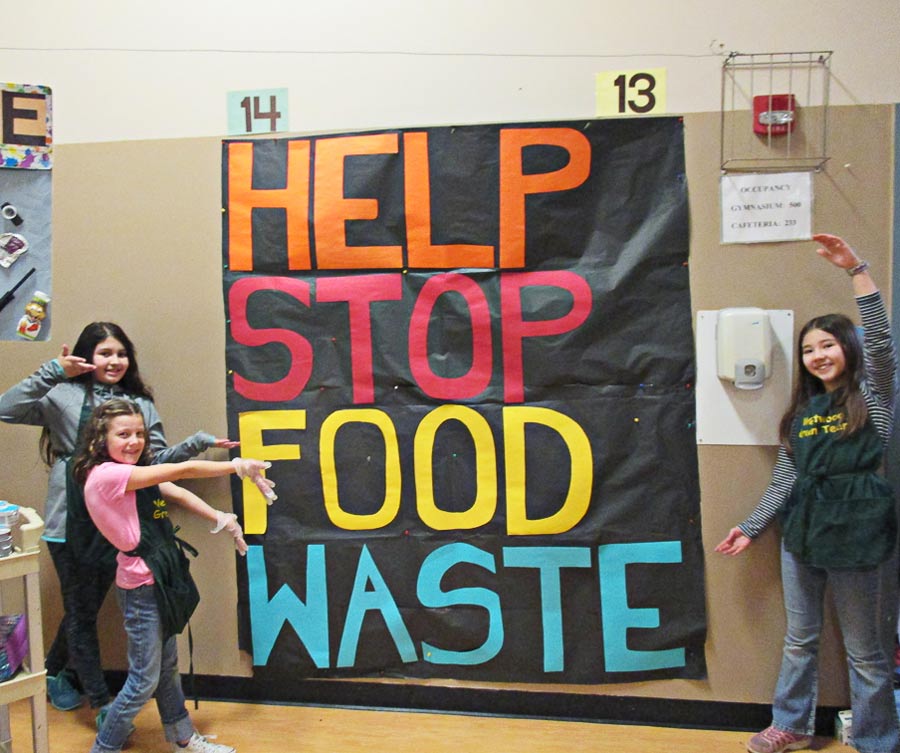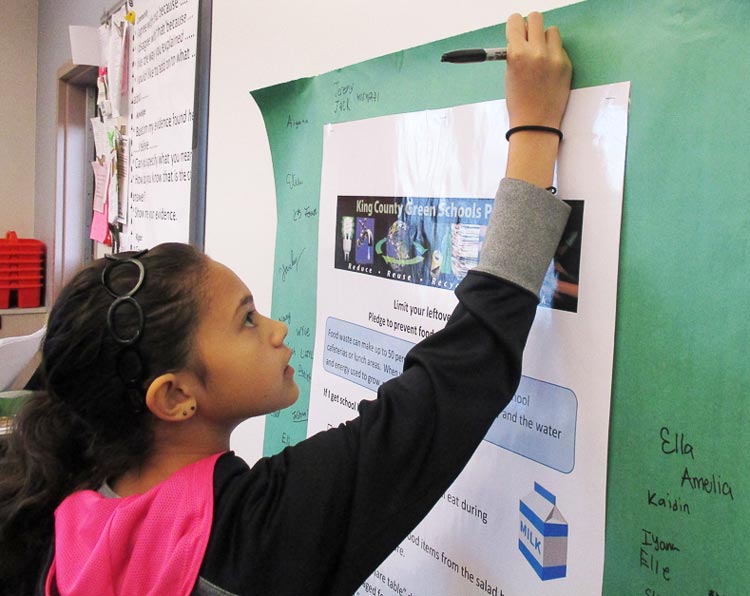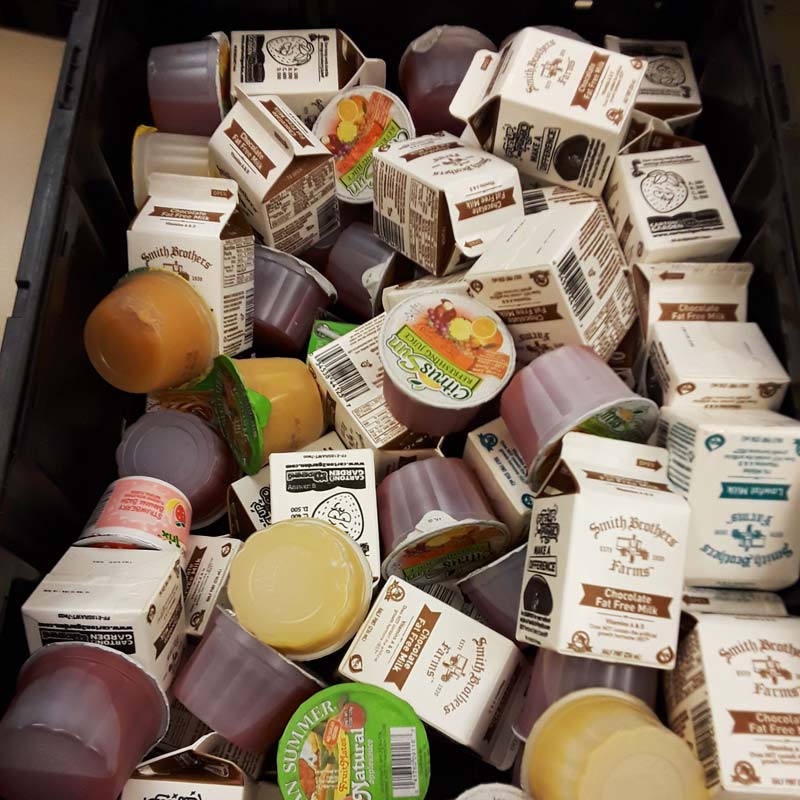Reducing food waste in schools
It's not nutrition if it's in a garbage or compost bin
Challenges and potential for reducing wasted food
- About one-third of food produced in the United States ends up in garbage bins. The energy, water and other resources used to produce, transport, and cook food is wasted when we waste food.
- In schools, students place uneaten edible foods in garbage or compost bins at the end of each lunch period. An average school throws away 30 pounds of food each day while one in five children are food insecure.
- Food Waste and Potential Food Rescue Programs for Auburn School District external link Download PDF - 2017 University of Washington Livable Year study conducted in partnership with City of Auburn, Auburn School District, and King County Green Schools Program. See summary on pages 6 and 7, and data on pages 27 – 30.
- Food waste in schools has been a problem for a long time, before federal nutrition standards for schools were updated in 2012 to make school meals healthier. See research external link indicating students are eating more of the healthier foods they are served after healthier standards were put into place.
We can reduce food waste in schools. See solutions below.

Education
Effective educational strategies include classroom lessons, nutrition education, school educational campaigns encouraging students to eat the foods and beverages they select, pledge campaigns to reduce wasted food, school produce gardens that involve students, and sharing tips with parents and guardians on how to pack lunches their children will eat.
- Pledge to reduce food waste at school Download PDF 250 K
- Food waste reduction campaign at Westwood Elementary School Download PDF 100 K
- How to pack a waste free lunch Download PDF 400 K
- Food waste reduction articles for families Download PDF 100 K
- Food for Thought workshop offered by King County for middle and high school classrooms. See secondary school classroom workshops
- Food systems and food waste reduction: Green Team and Classroom learning and activities Download PDF 200 K
- Sample announcements and newsletter articles tailored to each district and school are available from King County Green Schools Program for schools participating in the program
- School and district employees and secondary school students - Watch this 9-minute video from University of California: Food waste is the world's dumbest problem Youtube

Menu revisions
Keep track of lunch menu options that students typically do not eat, and share that information with school or district food services. School nutrition or food services may be able to revise future menus within the federal nutrition guidelines.
- Food waste inventory project - daily tracking sheet Download PDF 300 K
- Food waste inventory project - summary sheet Download PDF 225 K
Recess before lunch, Longer seated lunch periods
Studies show food waste per elementary school student decreased after recess was scheduled before lunch, and longer seated lunch periods in K-12 schools resulted in less food waste. Also, according to experts, when students eat more of the nutritious foods served at school, they experience improved physical health, emotional/social health, and cognitive function.
- Recess before Lunch: Summary of studies Download PDF 150 K
- Longer seated lunch period: Summary of studies Download PDF 225 K
Milk dispensers
In schools with milk dispensers, students choose how much milk to take, resulting in less milk waste because students drink more of what they put in their cups compared to what they drink from milk cartons. Students report that milk tastes better from dispensers than from cartons – and that also leads to less milk waste.
After switching to milk dispensers, schools and districts have realized cost savings thanks to reduced garbage or recycling collection costs, lower energy costs, and milk waste reduction resulting in less milk purchased.
- Milk dispensers in Canby School District, Oregon external link
- Analysis of milk dispensers and milk cartons for Auburn School District Download PDF 500 K
Report prepared by King County Green Schools Program with support from City of Auburn (January 2021)
Share Tables
A Food Share Table in a school cafeteria is a space for students to place unopened, packaged foods and drinks and uneaten whole fruits with inedible skins from the school lunch program. Typical items placed on Food Share Tables include unpeeled oranges and bananas, and unopened milk cartons, yogurts, cheese sticks, packages of crackers, and apple sauce or fruit cups. Invite students who want more food to help themselves to Food Share Table items.
King County Green Schools Program provides guidance, recommendations based on successes in King County schools, signs for Food Share Tables, and tools to help schools educate students about reducing food waste and using a Food Share Table.
See King County Green Schools Program Food Share and Donation Pilot – Lake Washington School District – final report June 2019 Download PDF 1.75 MB
Important: Before setting up a food share table
- Review this Public Health – Seattle & King County fact sheetDownload PDF 200 K.
- Public schools must obtain approval from their school district Food Services or Child Nutrition Services. Ask the Green Schools Program if your school district allows food share tables.
- For public schools: School districts must complete and submit a School Food Sharing Table request formDownload PDF 200 K for each school.
- For private schools: Each school must complete and submit a School Food Sharing Table request formDownload PDF 200 K.
- Food worker card: On the Public Health request form, there is a space to enter the name of the person who will be in charge of the Food Share table. The “food service manager” or “person in charge of the food share table” must be someone with a food worker card. To obtain a food worker card, a staff member or volunteer must take an online class, pass the test, and pay $10 to obtain a food worker card. See Online class and test - King County for details.
- Monitoring: Daily monitoring of the Food Share Table is required to make sure only accepted items are placed on the Food Share Table. In many schools, students and parent volunteers help monitor, and the person in charge sets up a volunteer schedule. Volunteer monitors do not need to have food worker cards, as long as the person in charge has a food worker card and instructs the volunteer monitors to follow food safety measures, including washing their hands and not allowing opened packaged, half-eaten items, or foods from home lunches to be placed on the Food Sharing Table.
Donation (also called Food Rescue or School Food Share)
Foods leftover on Share Tables can be donated to nonprofit organizations that will use the food to feed hungry people. Those nonprofit organizations also can pick up from school kitchens any foods and drinks that cannot be served at a future lunch.
To collect foods that have been served (such as in a school cafeteria), nonprofit organizations must receive a variance from King County Public Health. King County Green Schools Program connects schools and districts with nonprofit organizations that have received such a variance.
The program also provides hands-on assistance, recommendations based on successes in King County schools, crates to collect and store food, signs for the crates, and helpful resources.
Important: Before starting a donation program, ask King County Green Schools Program if your school district allows share tables and donation.
- How it Works Download PDF 100 K
- Myths and Facts about School Food Share Programs Download PDF 250 K
- Food donation tracking form Download PDF 300 K
At the end of every school year and prior to other long school breaks, school district kitchens typically have edible foods such as produce, dairy products, baked goods, and other foods that would spoil or reach expiration dates before school resumes.

Composting
Foods not eaten or donated can be collected for composting at a regional composting facility. See Food Scrap Collection Steps to Success Download PDF 175 K.
King County Green Schools Program provides hands-on assistance, indoor containers to collect food scraps and other compostable materials, signs, educational tools, and help educating students and employees about what materials can be composted. It is important that plastics, metals, glass, and other non-compostable items be kept out of compost bins.
- Call for parents to help with collection of compostable materials Download Microsoft Word document 90 K
- Sample announcements about collection of food scraps Download PDF 150 K
- Tips to prevent or reduce fruit flies Download PDF 125 K
Some schools compost food scraps on their campuses. See resources below.
- Commercial (businesses and schools) on-site food composting
- Report on pilot school and business on-site composting Download PDF 60 K
- King County Green Schools using Earth Tubs
- Crestwood Elementary School Download PDF 250 K (Kent School District)
- Waskowitz Outdoor School Download PDF 125 K in North Bend (Highline School District)
- Worm bin composting
- King County guide Download PDF 125 K to building, setting up, and maintaining a worm bin for educational purposes
- More information about worm bins


 Translate
Translate
